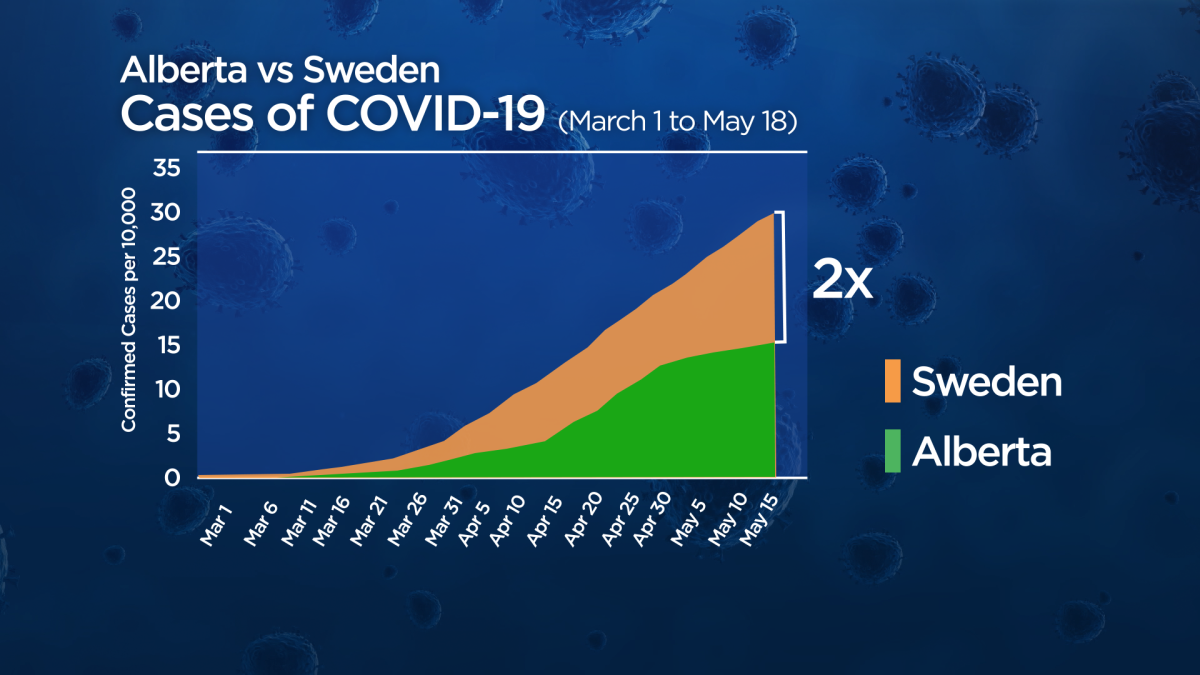Questions about whether Alberta could have implemented less strict COVID-19 restrictions like Sweden are difficult to answer, according to an infectious disease expert, because of differences in demographics when you compare the two.

“Each region has its own risk-factors as well as its own needs,” Dr. Craig Jenne, an infectious disease specialist at the University of Calgary, said Monday. “As a result, one reopening or one restriction plan will not work for all areas of the world.”
The approach Sweden took has made headlines worldwide for its softer methods.
That country banned gatherings of more than 50 people, closed high schools, colleges and universities, and urged isolation for citizens over the age of 70 or for those with underlying medical conditions who may be vulnerable to COVID-19.
However, Swedish elementary schools, most restaurants and most businesses remained open through the pandemic.
“We see other places where patios are still open, or restaurants are open. And we wonder why we can’t do that,” Jenne said.
“We fail to realize that often the background information is dramatically different.”
Last week, Alberta’s chief medical officer of health Dr. Deena Hinshaw said while there has been some negative responses to the more strict shutdowns put into place in the province, the demographics in Sweden made it more of a feasible approach there.
“More than half of all households in Sweden are single-person households,” Hinshaw said on May 19. “This means that distancing from others in daily life is much easier. In Alberta, less than a quarter of all households have only one person.”
She added while there weren’t enforced closures, Swedish authorities have been monitoring social distancing in public spaces and businesses. Hinshaw said she believes the advice-based approach the Nordic country took also came at a cost.

Get weekly health news
“My point is not that there is one right or wrong way to deal with the pandemic — but rather that there are costs to every choice,” she said.
“In Sweden, there has been a cost of higher death rates. In Alberta, as elsewhere around the world, there has been a cost of temporary restrictions on some freedoms.”

Alberta Health went so far as to post case comparisons between the province and Sweden.
According to the province, between March 1 and May 18, Sweden saw double the number of cases per 10,000 people, as well as 12 times the number of deaths.
For ICU cases, per 10,000 people, Sweden had to treat 18 times more patients.
“Here in Alberta, we’ve done a lot of the right things,” Jenne said. “We have a very low hospitalization rate, we have a very low death rate, and we have dramatically flattened the curve.
“So I think decisions made here have been quite effective in protecting the health of our population.”

He added while Sweden could be trying to achieve “herd immunity” to the virus — where enough of the population has been exposed that it slows the spread — with COVID-19 it’s difficult at this point to determine if herd immunity is even possible.
“Right now, we still don’t know if you test positive for these antibody blood tests, whether you’re actually protected. That’s one of the key aspects of herd immunity.
“We just don’t know that yet with this particular virus,” Jenne said.
Sweden has a population of more than 10.2 million, compared to Alberta’s 4.3 million.
According to John Hopkin’s University as of May 25, in Sweden there have been 33,843 confirmed cases of COVID-19 and 4,029 deaths.
Alberta’s stats, as of Sunday, sit at a total of 6,860 cases and 135 deaths.
Hinshaw said that Albertans should be taking the lower case numbers as evidence that the closures and actions in the province have been working.
“We must all continue to take precautions. Staying home when ill and acting responsibly when resuming some activities as restrictions are slowly lifted.”
“I thank all Albertans for the sacrifices they have made to get us to this point, to continue moving forward, we must take measured steps. We must work together,” Hinshaw said.
Alberta started to loosen its restrictions on May 14, with the Stage 1 reopening phase including restaurants, hair salons, and retail stores. Dates for Stage 2 have yet to be confirmed.\







Comments